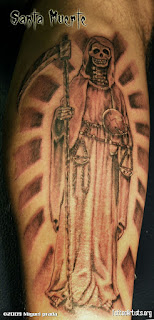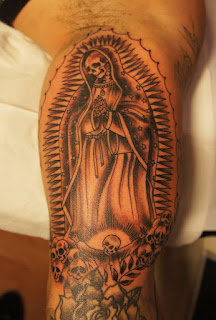Previous posts:
1. Death tattoos: Santa Muerte - origins and significations
2. Death tattoos: portrayals of the Santa Muerte
3. Santa Muerte tattoos: various elements which can occur in these tattoos
What could be the reason for getting a Santa Muerte tattoo? The first reason is the belief that Santa Muerte, being the saint of death, has the right to decide when one should die. By pleasing Santa Muerte, one can delay the moment of his / her death, can escape from deadly problems, etc. Besides, many of those who believe in Santa Muerte think that she can decide not only the moment of one's death but also the way in which a person will die and, consequently, a man need to gain her goodwill in order to receive a peaceful death.
Who are those willing to get a "Santa Muerte" tattoo? Initially, the Santa Muerte tattoos (just as the Santa Muerte worship) were popular only among thieves, drug-dealers, Mexican Mafia members, etc. For a stranger this might appear strange but most Mexicans and other Hispanic people, even though they are involved in gangs or other criminal activities, are deeply religious and rely on their Christian symbols to both identify and protect them. Moreover, they are exactly the people for whom the risk of death is always present and, quite obvious, they were the very first people willing to seek the Santa Muerte's protection. However, with the spread of the Santa Muerte worship, these tattoos ceased to be a symbol of the criminal underworld and nowadays there are hundreds or even thousands of ordinary Mexican Catholics who have an image of Santa Muerte tattooed on their bodies.
Are those tattoos "satanic tattoos"? On this issue, opinions are divided. The Roman Catholic Church has denounced the worship of Santa Muerte, considering it as a black magic and the Santa Muerte's followers as devil worshippers. On the other hand, many, if not all, of the Santa Muerte's followers consider themselves good Catholics. Santa Muerte figurines often stand near the statues of Jesus Christ or the Virgin of Guadalupe because the devotees to Santa Muerte do not see any contradiction between the Catholic faith and the worship of Santa Muerte. In many ways, a ritual dedicated to Santa Muerte is very similar to a Catholic rite, including procession and prayers for power healing, protection and favors.
Although there are many similarities between the two worships, Santa Muerte should not be confused with San la Muerte: San la Muerte is a "he" and is portrayed as a male skeleton, while Santa Muerte is a "she"; San la Muerte is venerated in the South America, not in Mexic; it seems that the San La Muerte cult is based on punishment and submission, etc. For more details about the San la Muerte cult visit this page: San La Muerte - Wikipedia, the free encyclopedia


















